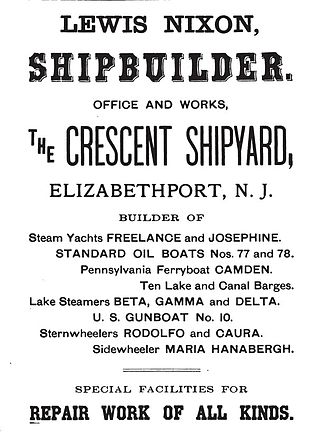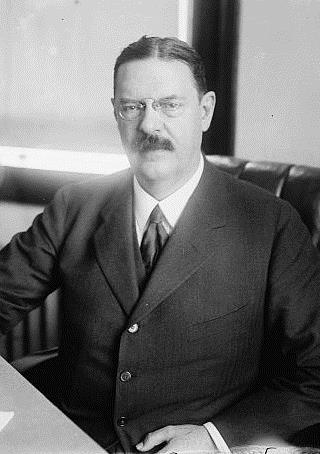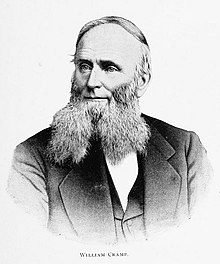
Newport News Shipbuilding (NNS), a division of Huntington Ingalls Industries, is the sole designer, builder, and refueler of aircraft carriers and one of two providers of submarines for the United States Navy. Founded as the Chesapeake Dry Dock and Construction Co. in 1886, Newport News Shipbuilding has built more than 800 ships, including both naval and commercial ships. Located in the city of Newport News, its facilities span more than 550 acres (2.2 km2).

USS Maine (BB-10), the lead ship of her class of pre-dreadnought battleships, was the second ship of the United States Navy to be named in honor of the 23rd state. Maine was laid down in February 1899 at the William Cramp & Sons shipyard in Philadelphia. She was launched in July 1901 and commissioned into the fleet in December 1902. She was armed with a main battery of four 12-inch (305 mm) guns and could steam at a top speed of 18 knots.

The Philadelphia Naval Shipyard was the first United States Navy shipyard and was historically important for nearly two centuries.

USS Albany (CA-123) was a United States Navy Oregon City-class heavy cruiser, later converted to the guided missile cruiser CG-10. The converted cruiser was the lead ship of the new Albany guided missile cruiser class. She was the fourth ship to carry the name Albany.

The New York Shipbuilding Corporation was an American shipbuilding company that operated from 1899 to 1968, ultimately completing more than 500 vessels for the U.S. Navy, the United States Merchant Marine, the United States Coast Guard, and other maritime concerns. At its peak during World War II, NYSB was the largest and most productive shipyard in the world. Its best-known vessels include the destroyer USS Reuben James (DD-245), the cruiser USS Indianapolis (CA-35), the aircraft carrier USS Kitty Hawk (CV-63), the nuclear-powered cargo ship NS Savannah, and a quartet of cargo-passenger liners nicknamed the 4 Aces.

USS Galveston (CL-93/CLG-3) was a Cleveland-class light cruiser of the United States Navy that was later converted to a Galveston-class guided missile cruiser. She was launched by William Cramp & Sons Shipbuilding Company, Philadelphia 22 April 1945, sponsored by Mrs. Clark Wallace Thompson. The cruiser's construction was suspended when nearly complete on 24 June 1946; and the hull assigned to the Philadelphia Group of the Atlantic Reserve Fleet. She was reclassified CLG-93 on 4 February 1956; then reclassified to CLG-3 on 23 May 1957; and commissioned at Philadelphia 28 May 1958.

Crescent Shipyard, located on Newark Bay in Elizabeth, New Jersey, built a number of ships for the United States Navy and allied nations as well during their production run, which lasted about ten years while under the Crescent name and banner. Production of these ships began before the Spanish–American War and occurred far before the outbreak of World War I. Arthur Leopold Busch, a recent emigre from Great Britain, started the yard with former Navy Lt. Lewis Nixon in January 1895. Both men previously worked for William Cramp & Sons in Philadelphia. Both Nixon and Busch were regarded to be amongst the best in their respected fields - and what they did at this time - as designers and builders of the latest, most advanced types of ships.

Union Iron Works, located in San Francisco, California, on the southeast waterfront, was a central business within the large industrial zone of Potrero Point, for four decades at the end of the nineteenth and beginning of the twentieth centuries.

USS Sablefish (SS/AGSS-303), a Balao-class submarine, was a ship of the United States Navy named for the sablefish, a large, dark fish found along North America's Pacific coast from California to Alaska.
The names of commissioned ships of the United States Navy all start with USS, for United States Ship. Non-commissioned, primarily civilian-crewed vessels of the U.S. Navy under the Military Sealift Command have names that begin with USNS, standing for United States Naval Ship. A letter-based hull classification symbol is used to designate a vessel's type. The names of ships are selected by the Secretary of the Navy. The names are those of states, cities, towns, important persons, important locations, famous battles, fish, and ideals. Usually, different types of ships have names originated from different types of sources.

Fore River Shipyard was a shipyard owned by General Dynamics Corporation located on Weymouth Fore River in Braintree and Quincy, Massachusetts. It began operations in 1883 in Braintree, and moved to its final location on Quincy Point in 1901. In 1913, it was purchased by Bethlehem Steel, and later transferred to Bethlehem Shipbuilding Corporation. It was sold to General Dynamics in 1963, and closed in 1986. During its operation, yardworkers constructed hundreds of ships, for both military and civilian clients.

Lewis Nixon was a naval architect, shipbuilding executive, public servant, and political activist. He designed the United States' first modern battleships, and supervised the construction of its first modern submarines, all before his 40th birthday. He was briefly the leader of Tammany Hall. He started an ill-fated effort to run seven major American shipyards under common ownership as the United States Shipbuilding Company, and he was the chair of the New York City commission building the Williamsburg Bridge.

Scotts Shipbuilding and Engineering Company Limited, often referred to simply as Scotts, was a Scottish shipbuilding company based in Greenock on the River Clyde. In its time in Greenock, Scotts built over 1,250 ships.
Stabilimento Tecnico Triestino (STT) ("Technical Establishment of Trieste") was a private shipbuilding company based in Trieste from the mid-19th to early 20th century, and the most important naval shipbuilding firm of the Austro-Hungarian Empire.

Neafie, Levy & Co., commonly known as Neafie & Levy, was a Philadelphia, Pennsylvania shipbuilding and engineering firm that existed from the middle of the 19th to the beginning of the 20th century. Described as America's "first specialist marine engineers", Neafie & Levy was probably the first company in the United States to combine the building of iron ships with the manufacture of steam engines to power them. The company was also the largest supplier of screw propellers to other North American shipbuilding firms in its early years, and at its peak in the early 1870s was Philadelphia's busiest and most heavily capitalized shipbuilder.

SS Illinois was an iron passenger-cargo steamship built by William Cramp & Sons in 1873. The last of a series of four Pennsylvania-class vessels, Illinois and her three sister ships—Pennsylvania, Ohio and Indiana—were the largest iron ships ever built in the United States at the time of their construction, and amongst the first to be fitted with compound steam engines. They were also the first ships to challenge British dominance of the transatlantic trade since the American Civil War.
















